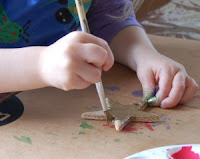Aromatherapy is the science of alternative medicine that uses volatile plant materials, known as essential oils, and other aromatic compounds for the purpose of improving a person's mood, cognitive function or health. In recent years there has been an interest is using aromatherapy for reducing the anxiety and behaviors associated with autism and other Sensory processing disorders.
In 1999 an OT named Jane Ellwood from the UK carefully planned and set up a structured program to use aromatherapy for a group of 6 non-verbal severely autistic children at a special needs school. The idea was to see if this would warrant further study. This would also provide an opportunity to document the therapeutic use and effects on children with sensory challenges.
5 different essential oils would be used-both stimulating and calming scents-and were selected based on their safe use with children, their ability to stimulate the olfactory sense, and their therapeutic properties:
Peppermint: A somewhat familiar scent. Acts as a neuro-stimulator. Widely used to improve concentration. Also has a cooling effect on the skin and can be used as an additional sensory experience.
Neroli: A non-irritating and sedating oil.Good for massage & when calming is needed. Also recommended fore obsessive behavior, one of the characteristics of autism.
Eucalyptus: Stimulating and clears nasal & bronchial passages allowing for deeper respiration.
Roman Chamomile: Calming and has been suggested to use for eye pillows and to counter act aggressive behaviors.
Sandalwood: Non irritating and scent contrasts to the other oils. Blends well with Neroli and would give an additional scent if needed.
Peppermint was used the first week initially in a room diffuser then in spray bottle allowing droplets to settle on the hands and feet of the children. Some children requested more. Jane observes how one child, who was tactile defensive, used the neck pillows filled with Roman Chamomile on his neck and remained calm and still the entire class despite usually having difficulties sitting still. One child who was overwhelmed by the new sensation at first, learned to shut his eyes when he was smelling the mint, thus avoiding sensory overload.
Later on, hand massage was introduced, using Neroli diluted in massage oil. One child who self-stimulated by spitting into his hands and rubbing it in found this to be a more pleasurable, calming and more acceptable activity. This child remained alert and participated in the group sessions and would request the oil when he needed his hands rubbed to calm down. He learned to do this for himself. After a few weeks, the children, some resistant to touch, were willing to rub each other's hands for a new sensation. Other objects, textures and hot/cold packs with the essential oils in or on them were slowly introduced each week to further expand and integrate the range of sensory experiences.
 |
In her conclusions, Jane states that "being aware of the often negative effects of sensory stimulation to children with autism, I had not expected the positive way the aromatherapy sessions were received. For all of the children, the experience has led to new opportunities for interaction & communication."
Overall, Ms. Ellwood concludes that the children reacted with interest and activity to the stimulating oils (peppermint & Eucalyptus) and receptiveness and calm with the calming oils, Neroli, Sandalwood and Roman Chamomile. However, the oils paired with the activity (massage, relaxation, etc. ) may also be a contributing factor in the outcome.
(Ms. Ellwood's study was published in Vol 1 • No 3 ~ Winter 2002-03 of "In Essence"- the quarterly Aromatherapy journal of the International Federation of Professional Aromatherapists)
Its important to not that before you introduce this type of sensory activity to your child check with his or her therapist or medical doctor. Also, be sure to use only natural essential oils and foods (coffee, oranges, lemons, basil, sage, lavender, etc.). Artificial scents, fabric softeners, & fragrances contain many chemicals that can cause headaches, nausea and other undesired affects on a child with sensitivities.
There are both strong supporters of this practice as well as others who say the effects cannot be proven. Most affects can be observed but are difficult to scientifically establish. You have to make these decisions for what is best and what will work for your students/child. It has been my own experience in a self contained classroom setting and with my own daughter, (who is not sensory challenged) that aromatherapy has a positive effect with careful application, dilligence & time.
A simple sensory activity to do with your child is "Scented Salt Dough". You can encourage your child to help you make this simple scented dough, and then use like clay to incorporate a variety of skills & sensory experiences (kitchen activities and "following a recipe" in general help improve auditory processing, visual processing, proprioception, fine motor skills, tactile senses, olfactory sense, language and socialization skills.)
You can also add rice, sand or other grainy substances to a different batch to increase the tactile response. (I don't suggest combining both scent and texture until after both types are introduced to the child/children and gotten used to.)
Some natural scents you can add to the dough: (be conservative & aware of what you are adding & whether or not a child has known skin sensitivities.)
Stimulating: Instant coffee, peppermint extract, lemon extract, pumpkin pie spice, cinnamon, ginger, ground cloves, basil, cherry kool aid,
Calming: vanilla extract, lavender, Roman Chamomile, Neroli, honey, anise extract, licorice or fennel
The dough can then be allowed to harden & painted for an extra creative & sensory experience!
For salt dough recipe and other sensory games & activities please visit our web page at: BodyLogique.com
To order a copy of "Calm & Connected: Yoga-Based Tools for Self-Regulation" (filled with dozens of simple, kid-friendly relaxation techniques) please use this link.
 |
| Calm & Connected by Barbara Gini |
For more information on Aromatherapy and autism, visit:
Aromatherapy-ADHD & Autism
Evaluating Aromatherapy Massage Effects on sleep in children with autism
Aromatherapy for ADHD
Receive S.M.Art Kids / Healthy Kids by Email
.
.









0 comments:
Post a Comment